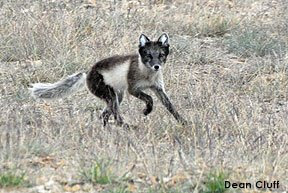DAVE: Our last night watching for wolves to interact with Elmer was uneventful except for the visit by a very nervous arctic fox that Dean can better describe. As we whiled away our last few hours fending off sleep and a light rain and hoping for just one more wolf visit to Elmer, we opined to each other how satisfying and scientifically fruitful this trip has been. We have been able to document two new pieces of interesting wolf information in our short visit: (1) the long daily distances wolves here travel from their den to areas with consistent food sources – daily round trips of over 40 km; and (2) the manner in which wolves examine strange wolves (Elmer) they encounter. Although the wolves made only two visits to Elmer, a total of 9 wolf visits were involved (1 night by one wolf plus 1 night by eight wolves). There appeared to be some strong commonalities in the ways all these wolves inspected Elmer. It will take several concerted examinations of the video tapes before we can be definitive about this behavior, but for now we believe we have some information that no one has known before. All that, and a glorious time, too! Thank you for joining us.
The wolf is superbly equipped for long-distance travel. From a literary standpoint, no one has described this adaptation better than Barry Lopez in his book Of Wolves and Men: “The movement down the trail would seem relentless if it did not appear so effortless. The wolf’s body, from neck to hips, appears to float over the long, almost spindly legs and the flicker of wrists, a bicycling drift (is) reminiscent of the movement of water or of shadows.” Unlike dogs whose elbows turn out, the elbows of wolves turn inward, thus allowing their feet to track in a straight line underneath their lean bodies. The long muzzle pulls in ample air to keep the blood oxygenated and the wolf’s internal cooling system finely tuned. Capable of moving along at a steady pace of 6 to 7 miles an hour depending on the terrain, the wolf can easily travel as many as 45 miles in a 24-hour period – perhaps more. The long, slender legs, huge feet with toes that grip and cling to rocks, and narrow chests allow wolves to plow through snow, climb boulder spills, and to accelerate their pace to achieve astonishing bursts of speed when chasing prey. Technological advances like satellite and GPS tracking devices have given scientists in the lower latitudes insight into precisely where collared wolves travel and how far. But not here, not in the high arctic. Dave and Dean have to rely on research conducted the old-fashioned way: long hours of observation where nothing seems to happen, their eyes intently sweeping the distant expanses of treeless landscape, watching for movement – and waiting.
DEAN: Last night was our final one in Eureka before heading south. One last time to watch for wolves. Dave and I set up Elmer, optimistic that at least some wolves from the previous night would return. However, no such luck. We did see the arctic fox, though, and it was comical how
 high-strung and skittish it was. The fox was convinced Elmer was a threat and gave him a wide berth. I got a picture of the fox on one of his retreats. A plane came into Eureka earlier in the evening and was supposed to continue immediately on south to Resolute, but bad weather there forced the crew to stay at the Eureka Weather Station. Although our scheduled plane was expected to arrive and leave with us on board sometime late in the afternoon today (Friday), Dave and I realized we might have to get on the delayed plane instead, the one that stayed overnight here. Sure enough, once morning came and the weather cleared a bit, we were off to Resolute. There was hardly enough time to say goodbye to the weather station crew, but we have many memories to cherish. Thanks, Dave.
high-strung and skittish it was. The fox was convinced Elmer was a threat and gave him a wide berth. I got a picture of the fox on one of his retreats. A plane came into Eureka earlier in the evening and was supposed to continue immediately on south to Resolute, but bad weather there forced the crew to stay at the Eureka Weather Station. Although our scheduled plane was expected to arrive and leave with us on board sometime late in the afternoon today (Friday), Dave and I realized we might have to get on the delayed plane instead, the one that stayed overnight here. Sure enough, once morning came and the weather cleared a bit, we were off to Resolute. There was hardly enough time to say goodbye to the weather station crew, but we have many memories to cherish. Thanks, Dave.
No comments:
Post a Comment